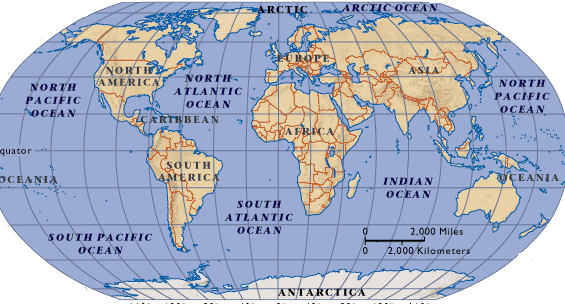Our planet is covered in water. The oceans cover more than two-thirds of the earth’s surface and contain almost all of the living space on the planet. That’s because the living space of the oceans is both on and below the surface. Miles below the surface.
Th e oceans have many different names—Pacific, Atlantic, Indian, Arctic, and Southern. But they are really part of one enormous water system that flows all over the globe. Water from the frigid Arctic Ocean makes its way around the world to Australia. Th e same water that laps the rocky coast of Maine will eventually reach the beaches in Thailand. In fact, oceanographers call Earth’s seawater a “world ocean,” since all of those bodies of water are connected.
words to known
species: a group of living things that are closely related and physically similar.
canyon: a deep trench in the earth, often with steep sides.
Mariana Trench: the deepest part of the world’s oceans, located in the Pacific, near Guam.
continental plates: the different portions of the earth’s crust that move over a long time.
polyps: small creatures that live in colonies and form coral.
algae: an organism that is similar to a plant because it turns light into energy but that does not have leaves or roots.
bleaching: when coral dies, it loses its color and becomes white, or bleached.
THE DIFFERENT OCEANS
Even though all the seawater in the world is one giant ocean with lots of different branches, these branches aren’t all the same. They are different sizes and shapes. Th e branches even have different characteristics and different species of plants and animals.
Th e five largest bodies (or branches) of seawater are the Pacific, Atlantic, Indian, Arctic, and Southern oceans, and all have special features that make them unique.
In terms of geography, seas are smaller than oceans and are usually located where the land and ocean meet. Typically, seas are partially enclosed by land. Seas are found on the margins of the ocean and are partially enclosed by land. Here, you can see that the Bering Sea is part of the Pacific Ocean.
The ocean is blue because water absorbs colors in the red part of the light spectrum. Like a filter, this leaves behind colors in the blue part of the light spectrum for us to see. The ocean may also take on green, red, or other hues as light bounces off of floating sediments and particles in the water.
The rain physically erodes the rock and the acids chemically break down the rocks and carries salts and minerals along in a dissolved state as ions. The ions in the runoff are carried to the streams and rivers and then to the ocean.
On the “near” side of the Earth (the side facing the moon), the gravitational force of the moon pulls the ocean’s waters toward it, creating one bulge. On the far side of the Earth, inertia dominates, creating a second bulge. In this way the combination of gravity and inertia create two bulges of water.
Currently, the most favored explanation for where the Earth got its water is that it acquired it from water-rich objects (planetesimals) that made up a few percent of its building blocks. These water-rich planetesimals would have been either comets or asteroids.

